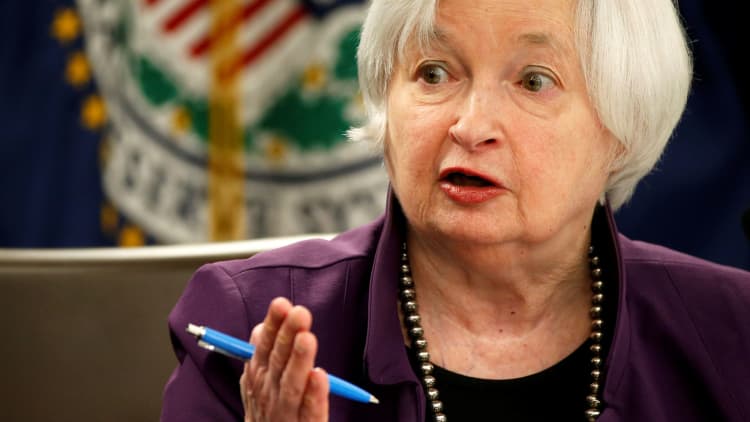
The Federal Reserve's most recent interest rate hike came amid worries that keeping policy loose was posing increasing risks to financial stability and the economy.
Fed officials indicated a determination to continue raising rates even with muted inflation levels, which they considered to be temporary and likely to rise over the long run to a targeted level of 2 percent, according to a summary from the June meeting of the policymaking Federal Open Market Committee.
The Fed raised its benchmark rate target a quarter point at the meeting and outlined a plan to reduce its $4.5 trillion balance sheet of bond holdings it accrued while trying to stimulate the economy during and after the financial crisis. Meeting minutes released Wednesday indicated that Fed officials believe the balance sheet can be reduced with "limited" disruption to financial markets.
Officials also expressed little concern that low inflation would persist.
However, Fed officials were divided on when the balance sheet runoff should begin, and did not release a timetable on when it would happen.
Recent readings below the Fed's 2 percent goal were attributed to "idiosyncratic factors, including sharp declines in prices of wireless telephone services and prescription drugs, and expected these developments to have little bearing on inflation over the medium run."

The rate hike came as several officials voiced concern over the effect, or lack thereof, that their recent measures were having on financial markets. Rather than causing conditions to tighten, they actually have grown looser since the central bank embarked on a series of hikes.
While the Fed has increased its benchmark rate target four times since December 2015, government bond yields have declined in recent months. Stocks have continued to gain in the second-longest bull market ever recorded, and multiple other measures of financial conditions remain loose.
The meeting minutes reflected considerable discussion over why that was happening.
Low bond yields, they reasoned, could be the product of "sluggish longer-term economic growth" as well as the Fed's $4.5 trillion balance sheet of bond holdings.
On stock prices, FOMC members "suggested that increased risk tolerance among investors might be contributing to elevated asset prices more broadly; a few participants expressed concern that subdued market volatility, coupled with a low equity premium, could lead to a buildup of risks to financial stability."
In addition to approving a quarter-point hike at the meeting, the committee also set the parameters under which it would unwind the balance sheet. The Fed currently reinvests the proceeds it gets from the bonds, but will begin allowing $10 billion to roll off in quarterly increments until it reaches $50 billion a month. That process is likely to continue until the balance sheet reaches about $2 trillion to $2.5 trillion.
Fed Chair Janet Yellen has said that the hope is to have the balance sheet reduction happen in "the background" with little notice from markets.
"The effect on financial market conditions of the eventual announcement of the beginning of the Federal Reserve's balance sheet normalization was expected to be limited," the minutes said.
The moves to raise rates and reduce the balance sheet come amid some worry in markets over whether the Fed should be tightening with inflation so low. The central bank's preferred measure of inflation is running at about a 1.4 percent annual level, well below the 2 percent Fed target.
Minneapolis Fed President Neel Kashkari was the sole dissenter during the policy vote, reasoning that the committee should await more evidence that inflation is moving toward the goal. Some economists have encouraged the Fed to raise its inflation target.
Members also debated whether the Fed should allow the unemployment rate, currently at 4.3 percent, to undershoot what the Fed considers full employment, or 4.7 percent. The discussion again turned to the financial stability risks of loose policy. More hawkish committee members worry that if the Fed stays too low for too long, it could be forced to tighten hastily and risk economic damage.
"A couple of participants expressed concern that a substantial undershooting of the longer-run normal rate of unemployment could pose an appreciable upside risk to inflation or give rise to macroeconomic or financial imbalances that eventually could lead to a significant economic downturn," the minutes said.


